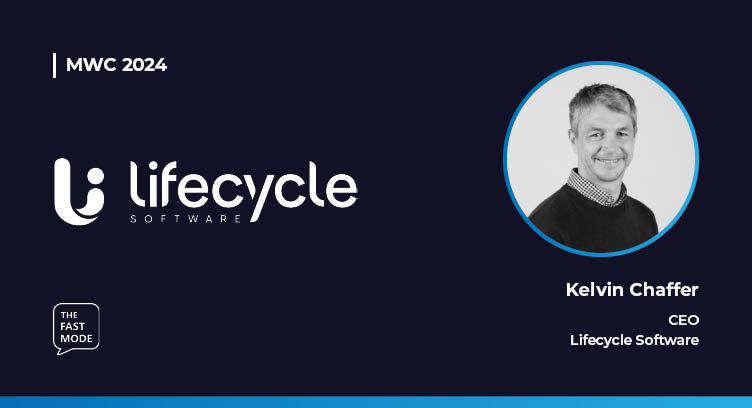With MWC Barcelona taking place this week at the Fira Gran Via, Ariana Lynn, Principal Analyst at The Fast Mode spoke to Kelvin Chaffer, CEO of Lifecycle Software on the company's participation at the event.
Ariana: What are some of the key themes of this year's MWC?
Kelvin: ‘Humanising AI’ is one of MWC’s themes in Barcelona this year, and the application of AI to the telco business model in order to enhance the customer experience is certainly a key strategy area.
Gen AI can significantly enhance telcos' ability to target niche markets through more precise and personalised strategies.
AI models can allow telcos to analyse vast amounts of data, gaining deeper insights into the preferences, behaviours, and needs of specific niche segments. This data-driven approach enables telcos to orchestrate their products, services, and marketing campaigns with a higher degree of accuracy, resonating more effectively with the unique requirements of niche markets.
Furthermore, Gen AI can facilitate improved customer engagement and communication. By integrating AI-powered chatbots and virtual assistants, telcos can offer real-time, personalised interactions, addressing the specific concerns and preferences of niche market segments.
Integrating advanced large language models like ChatGPT into existing BSS systems, CRM and chatbots, telcos can provide customers with immediate, detailed responses imbued with a uniquely conversational touch. The incorporation of specific tones, writing styles, and messaging not only ensures accurate information delivery but also fosters a distinct brand identity, elevating the overall customer experience and strengthening brand loyalty in a competitive market.
But beyond the customer relationship, telcos can also use AI and machine learning to combat the evolving telecom fraud threat to counter sophisticated tactics like SIM exchange, SMS phishing, and even cyber-attacks to the network’s integrity and functioning. By using AI and ML to develop predictive models, assess susceptibility to fraud, and instantly react to any fraudulent activities, both customers and the network can be protected.
Real-time analytics and AI address the core aspects of data trust, identifying and resolving anomalies across the complete data lifecycle. By leveraging these technologies, telcos can promptly identify and neutralise threats, enhance efficiency, and improve customer experience, ultimately saving on infrastructure and operations costs.
Indeed, network security is an important consideration for two other core MWC themes for 2024 - “5G and beyond'' and “Connecting Everything”. Ongoing enhancements in 5G network slicing demand adaptive security protocols, emphasising the need for continuous research and adaptability in the dynamic 5G landscape. Moreover, as 6G networks emerge and IoT devices proliferate, security measures need to evolve for seamless integration and to ensure robust protection.
Ariana: What are some of the events that Lifecycle has lined up? Any showcases?
Kelvin: Lifecycle Software’s focus at MWC in 2024 will be the launch of NEXUS™ - an MVNE Platform designed to facilitate the quick set-up and operation of neo telcos and MVNOs. Offering a first of its kind 'Telco in a Box' approach, NEXUS provides brands with the requisite agility, reliability, and flexibility for anyone to launch a neo telco and become.
The transformative platform not only simplifies and expedites the process of harnessing the network but empowers any brand to launch and operate mobile services swiftly. It significantly reduces associated costs and barriers to entry, ushering in a new era of accessibility and innovation in the mobile services sector.
NEXUS supports the full life cycle of an MVNO, from launch and onboarding to SIM provisioning, subscriber engagement and retention, providing all the necessary network integrations with a suite of built-in applications and automated workflows.
It can be used by both new players and established MVNOs to enable MVNO launch in under three months if network criteria are met. Its cloud native tech stack, with OpenAPIs, is designed for efficiency and resilience, and includes white-labelled front ends with pre-made plans.
Ariana: What's the outlook for telecoms, specifically the mobile industry in the next 12 months?
Kelvin: 2024 could very well mark a watershed moment for the mobile industry, particularly for MVNOs. Lowered costs and technological advancements are not just lowering the barriers to entry, they are inviting innovation and competition into a space that has long been the playground of a select few. Advances in Business Support Systems (BSS), favourable wholesale rates, and streamlined regulations, combined with network sharing arrangements and white-label solutions are enabling MVNOs to operate at a fraction of the historical costs, creating a fertile ground for new entrants. This situation will be further accelerated by advances in eSIMs.
Effectively, this means that any brand that wants to be a telco or a “neo telco” can now do it more easily, setting the stage for an unprecedented explosion of MVNO brands. The drastically reduced cost structures and flexibility offered by eSIM technology will contribute to a slew of brands offering SIM-only deals as an extension of their existing product lines. For end-users, this results in more choice, better services, and potentially lower prices, reshaping the competitive landscape of mobile telecommunication as we know it.
Indeed, eSIM technology is set to revolutionise the subscriber experience, not only offering an enhanced user experience through seamless onboarding and easy switching between plans or carriers, but also lowering the barriers to market entry by removing the need for physical logistics. From Apple to Samsung, all mobile brands are now focused on the power of embedded SIM cards. The list of eSIM-ready devices is growing, and the pace will accelerate in 2024 as eSIMs eliminate the need for physical SIM cards, radically simplifying the provisioning process and significantly reducing operational costs for MVNOs.




















